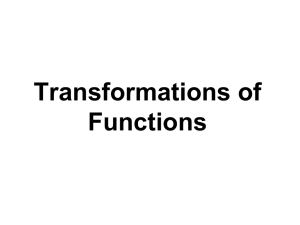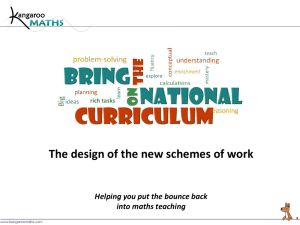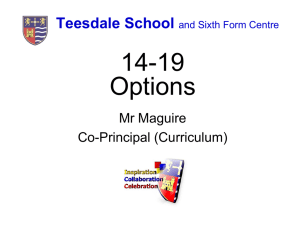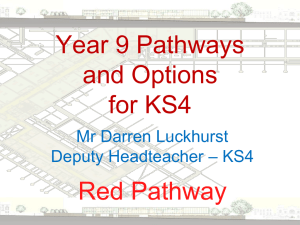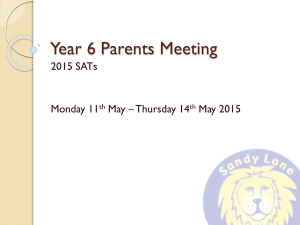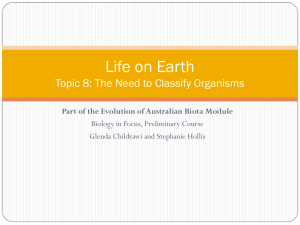Tom`s Presentation
advertisement
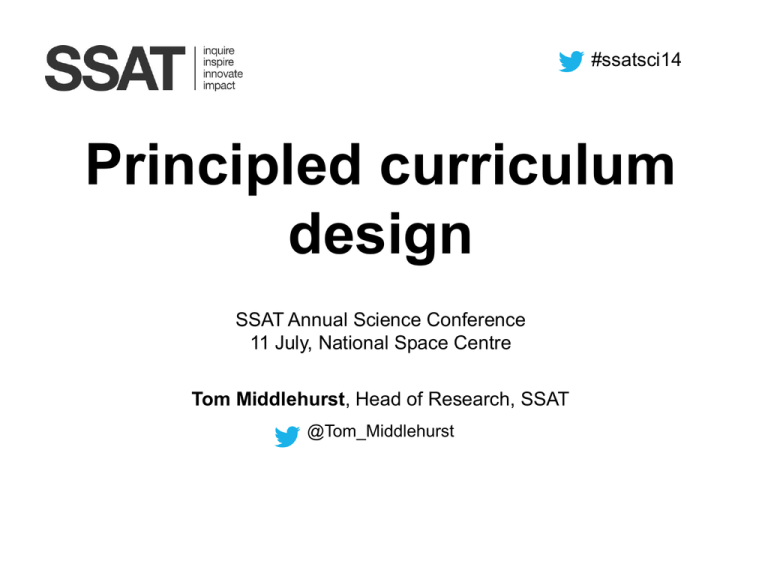
#ssatsci14 Principled curriculum design SSAT Annual Science Conference 11 July, National Space Centre Tom Middlehurst, Head of Research, SSAT @Tom_Middlehurst #ssatsci14 Accountability: some context to curriculum design #ssatsci14 Progress 8 and floor target A measure of progress, KS2 to KS4: a score showing how much result vary above or below expected levels. Expected levels will score zero - and below expected levels will mean a minus score. Floor target will be half a grade below expected. The average of all students' progress across 8 subjects: 1. a double-weighted English element (Lang & Lit have parity – both must be taken) 2. a double-weighted maths element 3. three other EBacc subjects 4. three further "high value qualifications" #ssatsci14 Three (or four?) other measures • Progress 8 •Attainment 8 – the average grade students achieve in the same P8 subjects • % English/Maths – the % of students who achieve a C+ in English (either Lit or Lang) and maths • % Ebacc – the % of students who achieve Ebacc • Looking to introduce a destination measure as well #ssatsci14 Outcomes beyond examinations #ssatsci14 Why do we educate young people? Broad views on the philosophy of education (Williams, 1961) Transmission of culture (e.g. Arnold) Preparation for work (e.g. OECD) Personal empowerment (e.g. Freire) Preparation for citizenship (e.g. Council of Europe) #ssatsci14 #ssatsci14 Setting the scene #ssatsci14 Some ancient history Education Reform Act 1988 National curriculum • Attainment targets • Programmes of study • Assessment arrangements #ssatsci14 Duties of the secretary of state 1. It shall be the duty of the Secretary of State so to exercise the powers conferred by subsection (2) below as a) b) to establish a complete National Curriculum as soon as is reasonably practicable (taking first the core subjects and then the other foundation subjects); and to revise that Curriculum whenever he considers it necessary or expedient to do so. #ssatsci14 2. The Secretary of State may by order specify in relation to each of the foundation subjects— a) such attainment targets; b) such programmes of study; and c) such assessment arrangements; 3. An order made under subsection (2) above may not require— a) that any particular period or periods of time should be allocated during any key stage to the teaching of any programme of study or any matter, skill or process forming part of it; or b) that provision of any particular kind should be made in school timetables for the periods to be allocated to such teaching during any such stage. #ssatsci14 What is curriculum? #ssatsci14 Curriculum: an evolving context The courses taken (Scottish HE, late 17th century) Four questions (Tyler, 1949) What educational purposes should the school seek to attain? What educational experiences … are likely to attain these purposes? How can these educational experiences be effectively organized? How can we determine whether these purposes are being attained? “All the learning which is planned or guided by the school, whether it is carried on in groups or individually inside or outside the school.” (Kerr, 1968 p. 16) “the school curriculum (in the wider sense) is essentially a selection from the culture of a society.” (Denis Lawton 1975 p. 7) #ssatsci14 The role of teachers (Stenhouse 1975) “A curriculum is an attempt to communicate the essential principles and features of an educational proposal in such a form that it is open to critical scrutiny and capable of effective translation into practice.” (p. 5) The proposal should have three parts: a) In planning b) In empirical study c) In relation to justification #ssatsci14 Wiliam’s principles of curriculum design • A good curriculum is: Balanced Rigorous Coherent Vertically integrated Appropriate Focused Relevant #ssatsci14 Balanced “We are the first generation of educators who know we have no idea what we’re doing . . . Because we have no idea what is coming, we have to future proof our students, and the way to do that is with a broad and balanced curriculum” #ssatsci14 Balanced The test of successful education is not the amount of knowledge that a pupil takes away from school, but his appetite to know and his capacity to learn. If the school sends out children with the desire for knowledge and some idea how to acquire it, it will have done its work. Too many leave school with the appetite killed and the mind loaded with undigested lumps of information. The good schoolmaster is known by the number of valuable topics which he declines to teach. (Sir Richard Livingstone, President of Corpus Christi College, Oxford, “The purpose in education” 1941) #ssatsci14 Discussion point How do we achieve a broad curriculum (across the school and in subjects) that prepares students for anything they might want to do in the future? #ssatsci14 Rigorous: Disciplinary habits of mind are important, specific, powerful ways of thinking that are developed through sustained engagement with the discipline. Mathematics: transformation and invariance History: provenance and context Statistics: dispersion as well as central tendency Sociology: structure and agency #ssatsci14 Rigorous: Cognitive competencies Cognitive processes and strategies Knowledge Creativity Intra-personal competencies Intellectual openness Work ethic/conscientiousness Positive core self-evaluation Inter-personal competencies Team-work Leadership Pellegrino and Hilton (2012) #ssatsci14 Discussion point How can we be faithful to the discipline of our subject? #ssatsci14 Coherent: Subject-based curricula support disciplines but tend to undermine coherence across different aspects of learning How can you make sure that the totality of students’ experiences reinforce one another? #ssatsci14 Discussion point How can we ensure that the totality of students’ experiences reinforce each other? #ssatsci14 Vertically integrated In which order would you teach the areas of the following shapes (currently arranged alphabetically)? Parallelogram - 3 Rectangle - 2 Square - 1 Trapezium - 5 Triangle - 4 #ssatsci14 Vertically integrated • Universal – Addition before multiplication • Natural – Multiplication before division – Differentiation before integration • Arbitrary – Areas of triangles before areas of parallelograms • Optional – The Romans before the Vikings #ssatsci14 Vertically integrated: The “spiral curriculum.” If one respects the ways of thought of the growing child, if one is courteous enough to translate material into his logical forms and challenging enough to tempt him in advance, then it is possible to introduce him at an early age to the ideas and styles that in later life make an educated man. We might ask, as a criterion for any subject taught in primary school, whether, when fully developed, it is worth an adult’s knowing, and whether having known it as a child makes a person a better adult. If the answer to both questions is negative or ambiguous, then the matter is cluttering the curriculum. Bruner, J. (1960). The Process of Education #ssatsci14 Discussion point How does our curriculum promote progression over time? #ssatsci14 Appropriate – 485 + 214 Leverhulme Numeracy Research Programme 1.00 Over 5 years, the increase in facility is 75%—an average of 15% per year. 0.90 0.80 Facility 0.70 0.60 0.50 0.40 0.30 In other words, in a class of 30, only four or five children learn this each year. 0.20 0.10 0.00 6 7 8 28 9 Age (years) 10 11 12 #ssatsci14 Discussion point How do we know we’re teaching the right content at the right stage? #ssatsci14 Focused (ten big ideas) 1 2 3 4 5 6 7 8 9 10 All material in the Universe is made of very small particles. Objects can affect other objects at a distance. Changing the movement of an object requires a net force acting on it. The total amount of energy in the Universe is always the same but energy can be transformed when things change or are made to happen. The composition of the Earth and its atmosphere and the processes occurring within them The solar system is a very small part of one of millions of galaxies in the Universe. Organisms are organised on a cellular basis. Organisms require a supply of energy and materials for which they are often dependent on or in competition with other organisms. Genetic information is passed from one generation of organisms to another. The diversity of organisms, living and extinct, is the result of evolution. 30 #ssatsci14 Discussion point How use our curriculum time parsimoniously? (cf big ideas) #ssatsci14 Relevant • About what to learn (Curriculum) • About how to learn (Pedagogy) • Degree of choice should be influenced by – Consequences (for the individual and for society) – Maturity • Consequences of choices (and especially poor choices) about what is to be learned are generally greater than choices about how learning should be achieved, so – For younger learners, many if not most learning outcomes need to be nonnegotiable. As they get older their wishes should become predominate their interests (progressive lowering of the “safety net”) – From the earliest age, however, learners should be involved in decisions about how they learn best. #ssatsci14 Relevant Intrinsic factors What is the subject really like? Authenticity of experience Habits of mind Developing identity (e.g., mathematics, plumbing) Extrinsic factors “Critical filters” for particular careers Financial rewards Consequences Closing down of options (“leaky pipes”) Sensitive periods #ssatsci14 Discussion point How do we contextualise the curriculum and give students informed choice about what they learn and how they learn it? #ssatsci14 Wiliam’s principles of curriculum design • A good curriculum is: Balanced Rigorous Coherent Vertically integrated Appropriate Focused Relevant

